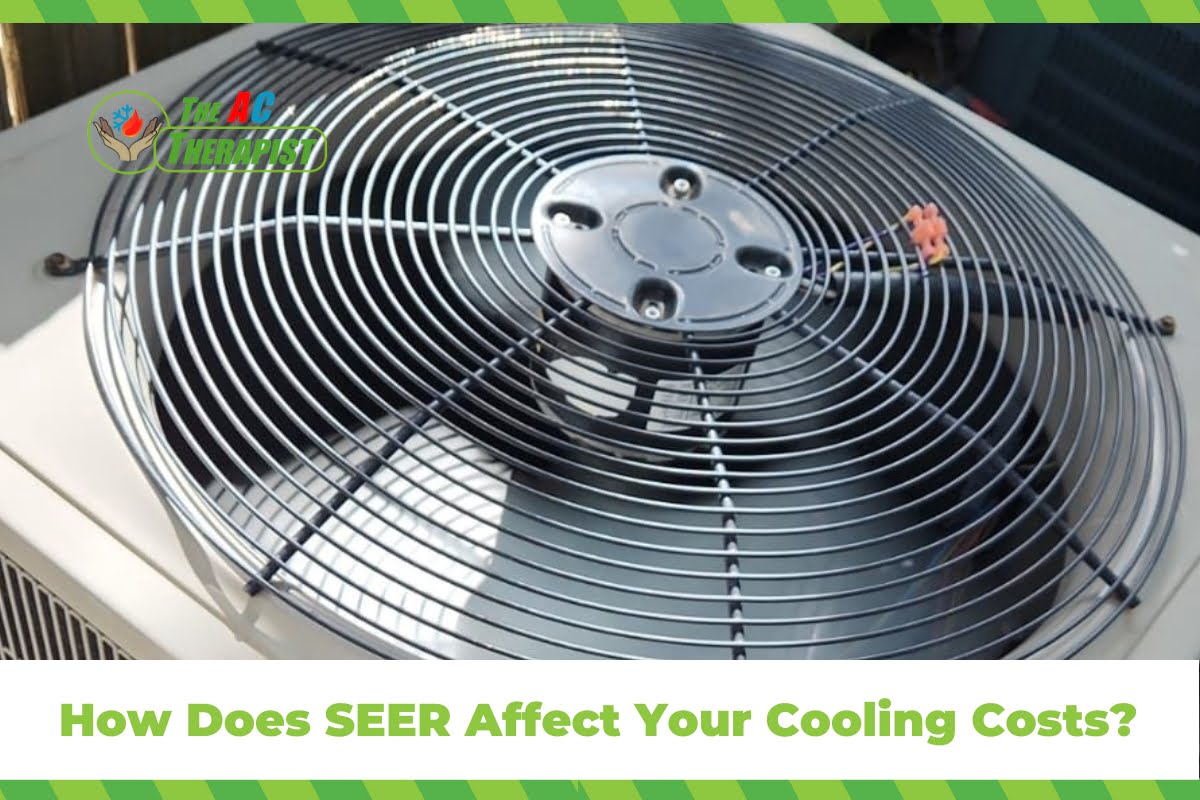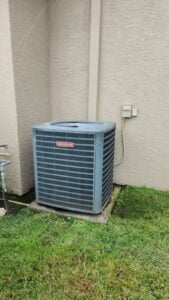How Does SEER Affect Your Cooling Costs?
SEER Seasonal Energy Efficiency Ratio is a numerical value that represents the efficiency of an air conditioning system. It measures how effectively the unit converts electricity into cooling output over the course of a typical cooling season. Higher SEER ratings indicate greater energy efficiency.
Why SEER Matters
SEER matters because it directly affects your energy consumption and, consequently, your utility bills. A higher seasonal energy efficiency ratio rating means your air conditioner can provide the same level of cooling with less electricity, saving you money and reducing your environmental impact.
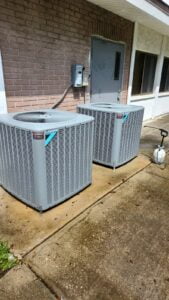
How SEER Is Calculated
SEER, or seasonal energy efficiency ratio, is a critical metric for evaluating the efficiency of air conditioning systems. But how exactly is the seasonal energy efficiency ratio calculated, and what does it reveal about an AC unit’s performance? In this blog, we’ll take a closer look at the science behind seasonal energy efficiency ratio calculations to help you better understand this essential aspect of air conditioner efficiency.
The Basic SEER Formula
At its core, SEER is a ratio that measures how efficiently an air conditioner converts electrical energy into cooling power. The formula for calculating the seasonal energy efficiency ratio is relatively straightforward:
SEER = Total Cooling Output (in BTUs) / Total Energy Consumption (in watt-hours)
Let’s break down each component of this formula:
1. Total Cooling Output (in BTUs)
The numerator of the seasonal energy efficiency ratio equation represents the total amount of cooling provided by the air conditioner over the course of a typical cooling season. This cooling output is measured in BTUs, or British Thermal Units, which quantify the amount of heat energy removed from the indoor air.
To determine the total cooling output, the air conditioner’s performance is assessed under various temperature conditions that mimic real-world usage. These conditions typically include different indoor and outdoor temperatures to simulate the changing demands on the system throughout the cooling season.
2. Total Energy Consumption (in watt-hours)
The denominator of the seasonal energy efficiency ratio equation accounts for the total energy consumed by the air conditioner during the same cooling season. This energy consumption is measured in watt-hours, reflecting the electricity used to operate the system.
To calculate the total energy consumption, the air conditioner’s power draw is monitored over the entire cooling season. This measurement takes into account the unit’s electrical efficiency, including any variations in energy usage as the temperature changes.
SEER vs. EER: What’s the Difference?
When you’re in the market for a new air conditioner, you’ll encounter various efficiency ratings, with two of the most common being SEER and EER. These acronyms represent important metrics that assess an air conditioner’s performance, but they do so in slightly different ways. In this article, we’ll explore the key distinctions between SEER (Seasonal Energy Efficiency Ratio) and EER (Energy Efficiency Ratio) to help you make an informed decision when choosing the right cooling system for your needs.
Comparing SEER and EER
Now that we’ve clarified their basic definitions, let’s compare SEER and EER in more detail:
1. Evaluation Period:
- SEER: Accounts for performance across an entire cooling season, incorporating variations in outdoor temperature and load conditions. This seasonal approach accurately represents how an air conditioner performs in real-world situations over time.
- EER: Evaluates efficiency under constant conditions. It offers a fixed-point measurement, which means it may not capture how well the system performs when faced with changing weather and cooling demands.
2. Range of Conditions:
- SEER: Considers a range of temperatures and part-load conditions. It provides a broader perspective on efficiency and is well-suited for regions with fluctuating weather patterns.
- EER: Focuses solely on a specific temperature scenario, making it more suitable for applications where conditions are relatively stable, such as commercial settings.
3. Applicability:
- SEER: This is commonly used for residential air conditioning systems. It helps homeowners understand how an air conditioner will perform throughout the year, accounting for seasonal variations.
- EER: This is often used for commercial air conditioning equipment. It provides a consistent measure of efficiency for systems operating in controlled environments.
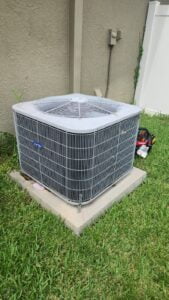
The Impact of SEER on Your Energy Bills
When the scorching summer heat hits, keeping your home cool is a top priority. However, that comfort often comes at a cost, as running your air conditioner can significantly impact your energy bills. This is where SEER, or seasonal energy efficiency ratio, plays a crucial role. In this article, we’ll explore how the seasonal energy efficiency ratio rating of your air conditioner can have a direct and substantial impact on your energy bills.
How SEER Affects Energy Consumption
SEER is a measure of how efficiently your air conditioner converts electricity into cooling power. The higher the seasonal energy efficiency ratio rating, the more efficiently it operates. This efficiency directly translates into reduced energy consumption. Here’s how it works:
- Lower SEER: Air conditioners with lower seasonal energy efficiency ratio ratings are less efficient. They require more electricity to produce the same amount of cooling. This means they run longer and consume more energy, leading to higher utility bills.
- Higher SEER: Air conditioners with higher seasonal energy efficiency ratio ratings are more efficient. They can deliver the same cooling output as lower SEER units while using less electricity. This results in shorter run times and lower energy consumption, leading to cost savings.
Calculating Potential Savings
The impact of the seasonal energy efficiency ratio on your energy bills becomes more apparent when you consider the potential savings. Let’s illustrate this with a hypothetical example:
Suppose you have two air conditioners, one with a seasonal energy efficiency ratio rating of 13 and another with a SEER rating 20. Both units aim to cool your home to the same temperature during the summer months.
- SEER 13 Unit: This unit is less efficient and consumes more electricity to maintain the desired temperature. As a result, your energy bills are higher.
- SEER 20 Unit: This unit is highly efficient and requires significantly less electricity to achieve the same cooling. Consequently, your energy bills are lower.
By upgrading to a higher SEER-rated unit, you can potentially reduce your cooling-related energy expenses by a substantial amount. The exact savings will depend on various factors, including your climate, usage patterns, and the efficiency of your existing system.
Benefits of High SEER Air Conditioners
In the world of air conditioning, efficiency matters. When you’re seeking optimal comfort during the hot summer months, and you want to keep your energy bills in check, the SEER rating of your air conditioner becomes a crucial factor. The seasonal energy efficiency ratio measures how efficiently your cooling system operates. Choosing a high-SEER air conditioner offers a range of benefits that go beyond just keeping your home cool.
1. Lower Energy Bills
One of the most significant advantages of a high-seasonal energy efficiency ratio air conditioner is the potential for lower energy bills. These systems are designed to operate more efficiently, meaning they can provide the same level of cooling while using less electricity. This translates into cost savings month after month.
For homeowners in regions with warm climates like Tampa Bay, where air conditioning is a constant need, the energy savings from a high-SEER unit can be substantial. Over time, these savings can offset the initial investment in the unit itself, making it a financially savvy choice.
2. Environmental Benefits
High-SEER air conditioners are not just good for your wallet; they are also good for the environment. By reducing your energy consumption, you decrease your carbon footprint. This helps lower greenhouse gas emissions, contributing to a more sustainable and eco-friendly lifestyle.
Choosing an energy-efficient air conditioner is a way to align your home’s comfort needs with environmental responsibility. It’s a small step that can have a positive impact on the planet.
3. Improved Comfort
Efficiency goes hand in hand with comfort. High-SEER air conditioners are often equipped with advanced features that enhance your indoor comfort. Here’s how:
- Temperature Control: High-SEER units can better regulate temperature, ensuring that your home stays consistently comfortable even during the hottest days.
- Humidity Management: Efficient systems can effectively control humidity levels, reducing that sticky, uncomfortable feeling in the air.
- Reduced Noise: Many high-SEER air conditioners are designed with noise reduction features, ensuring a quieter operation and a peaceful home environment.
4. Potential for Government Rebates
In some regions, government incentives and rebates are available to encourage homeowners to choose energy-efficient appliances, including high-SEER air conditioners. These incentives can further reduce the upfront cost of upgrading to a high-SEER unit, making it an even more attractive option.
Be sure to check with your local energy providers and government agencies to see if there are any available programs that can help offset the cost of your new air conditioner.
5. Long-Term Value
High-SEER air conditioners are designed for longevity. Their efficient operation puts less strain on components, leading to less wear and tear over time. This means your system is likely to have a longer lifespan, reducing the frequency of replacements and repairs.
Investing in a high-SEER unit isn’t just about immediate savings; it’s also about long-term value. You’re making an investment in a cooling system that will serve your home efficiently and reliably for years to come.
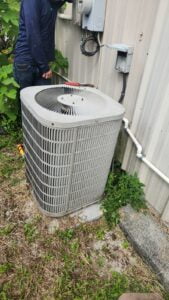
Maintaining Your SEER Rating
You’ve invested in an energy-efficient air conditioner with a high seasonal energy efficiency ratio rating to keep your home cool and your energy bills in check. However, to ensure that your cooling system continues to operate at peak efficiency, it’s essential to focus on maintenance. In this blog, we’ll explore the importance of maintaining your seasonal energy efficiency ratio rating and provide tips on how to preserve the efficiency of your air conditioning system.
The Importance of Regular Maintenance
Regular maintenance is the cornerstone of preserving your air conditioner’s seasonal energy efficiency ratio rating. Here’s why it matters:
- Efficiency Preservation: Over time, wear and tear can affect various components of your air conditioner. Regular maintenance helps identify and address issues before they compromise the system’s efficiency.
- Energy Savings: A well-maintained air conditioner operates more efficiently, using less energy to provide the same level of cooling. This translates into lower energy bills and cost savings.
- Lifespan Extension: Maintaining your air conditioner can extend its lifespan. By reducing strain on the system and addressing minor problems promptly, you can avoid costly repairs and premature replacements.
- Improved Indoor Air Quality: Proper maintenance includes cleaning and replacing air filters, enhancing indoor air quality, and promoting a healthier living environment.
Tips for Preserving Efficiency
To maintain your seasonal energy efficiency ratio rating and maximize the efficiency of your air conditioner, consider these maintenance tips:
- Regular Filter Replacement: Clean or replace air filters according to the manufacturer’s recommendations. Clogged filters restrict airflow and make your system work harder.
- Coil Cleaning: Dust and debris can accumulate on the evaporator and condenser coils, reducing efficiency. Schedule regular coil cleaning to keep your system running smoothly.
- Thermostat Calibration: Ensure that your thermostat is accurately calibrated to prevent overcooling or overheating. A well-calibrated thermostat helps your system maintain optimal temperature settings.
- Duct Inspection: Leaky or damaged ductwork can lead to energy wastage. Periodically inspect and seal any ductwork issues to maintain efficient airflow.
- Professional Tune-Ups: Schedule annual or bi-annual professional maintenance visits with a qualified HVAC technician. They can perform thorough inspections, clean components, and address any emerging issues.
- Refrigerant Levels: Ensure your air conditioner’s refrigerant levels are within the manufacturer’s specifications. Low refrigerant levels can reduce efficiency and cooling capacity.
- Proper Insulation: Ensure your home is adequately insulated to reduce the load on your air conditioner. Well-insulated homes require less cooling, improving overall efficiency.
- Shade Your Unit: If possible, provide shade for your outdoor condenser unit. Keeping it out of direct sunlight can improve its efficiency.
- Invest in a Maintenance Plan: Many HVAC contractors offer maintenance plans that include regular check-ups and discounts on repairs. Consider enrolling in one to ensure consistent maintenance.
When to Consider Upgrades
While regular maintenance can extend the life of your air conditioner and maintain its efficiency, there may come a time when upgrading to a more energy-efficient system makes sense. Here are a few signs to look out for:
- Aging System: If your air conditioner is nearing the end of its expected lifespan and requires frequent repairs, it may be more cost-effective to replace it with a newer, high-SEER unit.
- Declining Efficiency: If you notice a significant decrease in your air conditioner’s efficiency, even after maintenance, it could be a sign that the system is no longer performing optimally.
- Change in Cooling Needs: If you’ve made significant changes to your home, such as adding square footage or improving insulation, your cooling needs may have changed. In such cases, upgrading to a more efficient system can better meet your requirements.
Common SEER Myths and Misconceptions: Separating Fact from Fiction
SEER (Seasonal Energy Efficiency Ratio) is a critical factor when it comes to choosing an efficient air conditioner. However, like many technical aspects of HVAC systems, SEER can be surrounded by myths and misconceptions. In this article, we’ll debunk some common seasonal energy efficiency ratio myths and clarify the facts to help you make informed decisions about your cooling system.
Myth 1: Higher SEER Always Means More Savings
Fact: While higher seasonal energy efficiency ratio ratings generally indicate better energy efficiency, the potential savings depend on several factors. Your climate, usage patterns, and the energy costs in your area all play a role. If you live in a region with mild summers, the energy savings from upgrading to the highest SEER unit may not justify the additional cost. It’s essential to strike a balance between SEER and upfront cost based on your specific needs.
Myth 2: All SEER Ratings Are Equal
Fact: Not all seasonal energy efficiency ratio ratings are created equal. The SEER rating on an air conditioner label represents the system’s maximum efficiency under specific conditions. Real-world performance can vary based on factors like installation quality, maintenance, and local climate. Choosing a reputable HVAC contractor and ensuring proper installation and maintenance are crucial for achieving the rated seasonal energy efficiency ratio efficiency.
Myth 3: A Higher SEER Rating Is Always Better
Fact: While a higher SEER rating can lead to energy savings, it might not always be the best choice. The ideal SEER rating depends on your climate. In extremely hot climates like Tampa Bay, where air conditioning is used extensively, a higher SEER unit can provide significant savings over time. However, in milder climates, a lower SEER unit may be sufficient to meet your cooling needs without breaking the bank.
Myth 4: You Can Retrofit Any System to a Higher SEER Rating
Fact: It’s not always feasible to retrofit an existing air conditioning system to a higher SEER rating. Achieving a higher SEER typically requires replacing the entire system, including the outdoor condenser and indoor coil, with compatible components. Retrofitting can be costly and may not yield the expected efficiency gains.
Myth 5: Oversizing Doesn’t Affect SEER
Fact: Oversizing your air conditioner can impact SEER efficiency. An oversized unit may cycle on and off frequently, leading to inefficient operation. It’s essential to choose the right-sized air conditioner based on your home’s cooling load to maximize SEER efficiency.
Myth 6: SEER Is the Only Factor That Matters
Fact: While SEER is an important factor, it’s not the only one to consider. Other factors, such as the quality of installation, regular maintenance, and the condition of your ductwork, also play a significant role in determining your air conditioner’s overall efficiency and performance.
Myth 7: All SEER Ratings Are Verified
Fact: Not all SEER ratings are independently verified. It’s crucial to choose air conditioning units from reputable manufacturers that adhere to industry standards and testing procedures. Look for systems that have been certified by organizations like ENERGY STAR to ensure their SEER ratings are accurate and reliable.
Partnering with The AC Therapist for Efficient Cooling
In conclusion, the Seasonal Energy Efficiency Ratio (SEER) is not just a technical term; it’s a critical factor that can significantly impact your comfort, energy bills, and environmental footprint. Understanding SEER and its implications is key to making informed decisions when it comes to your air conditioning system.
As we’ve explored in this blog, SEER plays a central role in determining the efficiency of your AC unit. The higher the SEER rating, the more efficiently your system converts electricity into cooling power. This translates into lower energy bills, a reduced environmental impact, and enhanced indoor comfort.
For residents and businesses in the Tampa Bay area, where air conditioning is a vital part of daily life, the seasonal energy efficiency ratio rating of your cooling system should be a top consideration. When it comes to expert guidance on selecting, installing, and maintaining high-SEER air conditioning systems, look no further than The AC Therapist. As a local HVAC contractor specializing in residential and light commercial services, including AC repair, installation, maintenance, and more, they are your trusted partner in achieving optimal cooling efficiency.
The AC Therapist has the expertise and services you need. By making informed choices and working with professionals like The AC Therapist, you can enjoy a comfortable, cost-effective, and environmentally friendly indoor environment all year round.
So, remember, when it comes to the seasonal energy efficiency ratio and all your air conditioning needs in the Tampa Bay area, The AC Therapist is your go-to resource for expert advice and exceptional service.

